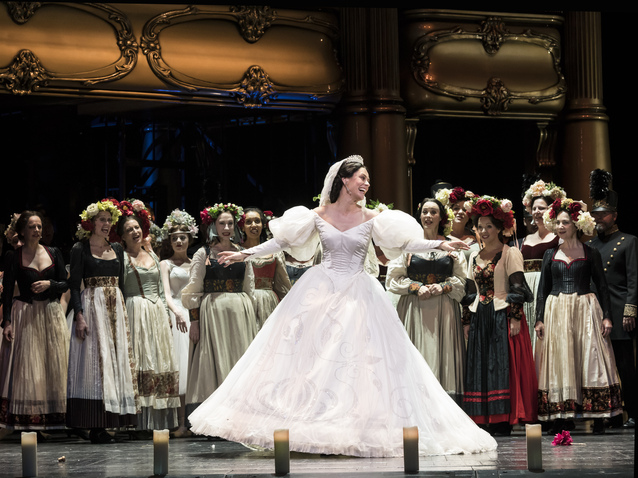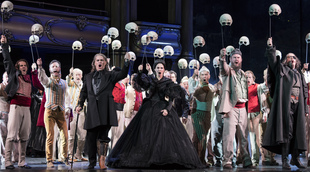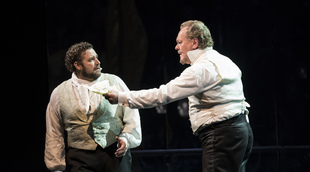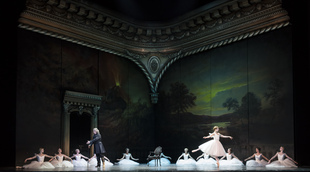 © (c) ROH - Bill Cooper
© (c) ROH - Bill Cooper
Giuseppe Verdi’s Les Vêpres siciliennes of 1855 tells of the French occupation of Sicily in the thirteenth century. Prior to the opera’s opening the Sicilian patriot Jean Procida was exiled and the French conqueror Guy de Montfort, who became the island’s governor, violated a Sicilian woman who subsequently had a son called Henri. At times the Sicilians are a little too ready to accept their subservient position, but three individuals are determined to set the island free, and frequently succeed in whipping up the crowd. The first is Procida, who during Act II returns from exile, the second is Henri, who at the start has no idea that Montfort is actually his father, and the third is Hélène, who seeks vengeance for the governor having killed her brother, Duke Frédéric of Austria.

Schrott (Jean Procida), Byströme (Hélène) ; © ROH - Bill Cooper

Bryan Hymel (Henri) & Michael Volle (Guy de Montfort) ; © ROH - Bill Cooper
Henri falls in love with Hélène, but the fact that Montfort is his father sees everyone face predicaments as their private feelings for individuals conflict with their public loyalty towards their people. Although Henri is an enemy of the French who would normally be taken from his prison cell to be executed, Montfort pardons and releases him because he is his son. When Montfort subsequently tells him who he is, the horrified Henri says this makes no difference to his loyalty to the Sicilians and refuses to call him father. Nevertheless, it still leads him to warn Montfort to flee when he knows Procida and Hélène are planning to kill him. This and Henri’s subsequent action helps Montfort to foil their plot, leading Procida and Hélène to face execution and to Henri being seen as a traitor.
When Montfort sees Henri’s willingness to die alongside Hélène, he realises their love for each other, and when (under coercion) Henri accepts Montfort as his father, he pardons them and supports their marriage. It looks for a while as if this will achieve a peace between the French and Sicilians, but Procida, who was also pardoned, still plans to defeat the French with the ringing of the wedding bells being the signal for his supporters to start their attack. When Hélène discovers this, she fears for Henri’s life and so says she cannot marry him in an attempt to ensure the bells are never rung. This leaves him distraught, as she cannot tell him her real reasons as she still feels loyalty towards her people. In the end, the bells are rung, having been instigated by both Procida, who wants the attack to start, and Montfort, who cannot understand why the pair would not want to be married, and the curtain falls on the Sicilians advancing.
Verdi wrote the opera when at the height of his powers, having enjoyed successes over the preceding years with Rigoletto, Il trovatore and La traviata. This encouraged him to compose a piece that in every way would fulfil the expectations of what a grand opéra, the style that was all the rage in Paris at the time, should be. The achievement of director Stefan Herheim, whose production first appeared at the Royal Opera House in 2013 and is now being revived by Daniel Dooner, is to instil the notion of the French grand opéra tradition into the very fabric of the staging. In this way, the scenario takes place largely in an opera house, and a second area that could be a rehearsal room. Theatres can be a place of escape for us all, and so it seems appropriate to position the French soldiers inside one when they sing of how residing in Sicily provides them with relief from their hard lives back home.
The theatre and backstage room could be metaphors for the countries, although it is not the case that one of the two spaces clearly represents France and the other Sicily. For example, the rehearsal room has a mural on the wall in the style of Nicolas Poussin, and yet within this stylised classical landscape the volcano could be Mount Etna and the ruins those of Agrigento.
During the Overture we see Procida as a dancing master teaching ballerinas. Then the French burst in, injure Procida and attack the women. Montfort rapes Henri’s mother but only after forcing everyone to dance and choosing the only one not to collapse from exhaustion, as if he is deliberately selecting the strongest to be his son’s mother.

Erwin Schrott (Jean Procida) with dancers ; © ROH - Bill Cooper
The dancers appear regularly throughout the opera, which ties in with the fact that dancing was an integral part of grand opéra. However, when we see the dancers who Montfort has conquered dressed in black, either appearing pregnant or with babies strapped around them, it seems as if we are witnessing a struggle between Procida and Montfort over whose tune Sicily will dance to. This is not to suggest that the two are as bad as each other because Montfort is an invading, violent rapist. Nevertheless, when we see Procida training up the dancers it is clear that he wishes to mould them in his own image of how an independent Sicily should be, and it is his rigidity on what is to be accepted as Sicilian that propels the violence when peace is a real option.
Aside from everything that the staging actually signifies, it is visually stunning as Philipp Fürhofer’s sets slide into various positions with immense slickness, mirrors are introduced to provide an additional reflective quality, and Anders Poll’s lighting designs feel positively inspired.
Musically, the evening is first rate. Maurizio Benini may not bring quite the same raw exuberance to the score as some conductors do, but the orchestral output is always smooth and focused, and never once is there any sense of momentum flagging over the fairly lengthy evening. Three of the four major principals reprise their roles from 2013, and all sing at the height of their game. The newcomer to the production is Malin Byström who plays Hélène and reveals real darkness in her lower register while still possessing sufficient brightness in her voice as a whole. Bryan Hymel displays the most expansive tenor in his extremely committed performance as Henri, Michael Volle provides an all-embracing sound as Montfort, while as Proceda Erwin Schrott’s bass-baritone is rock steady from start to finish.
By Sam Smith
Les Vêpres siciliennes | 12 October – 4 November 2017 | Royal Opera House, Covent Garden
the 16 of October, 2017 | Print
Comments